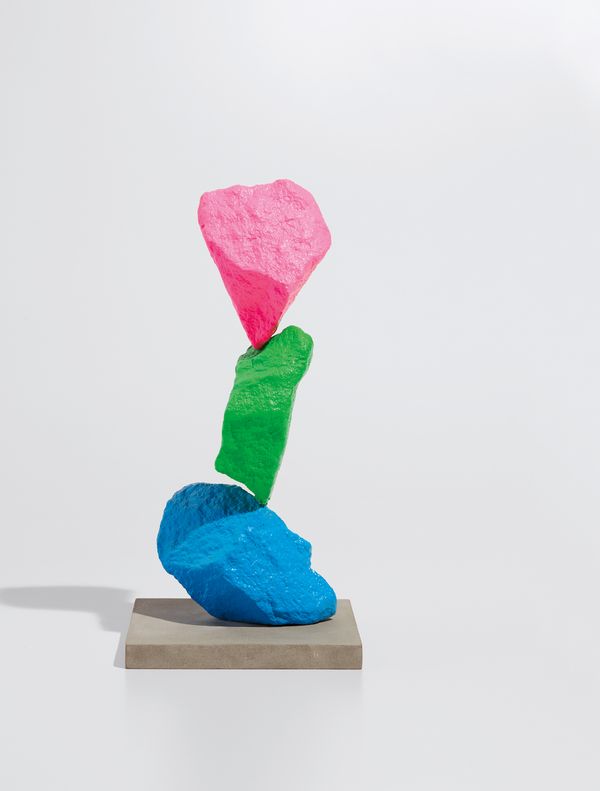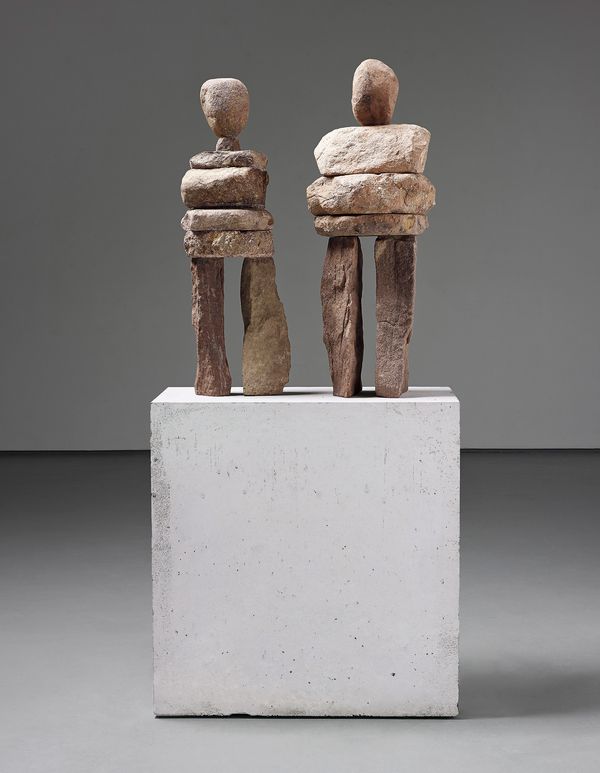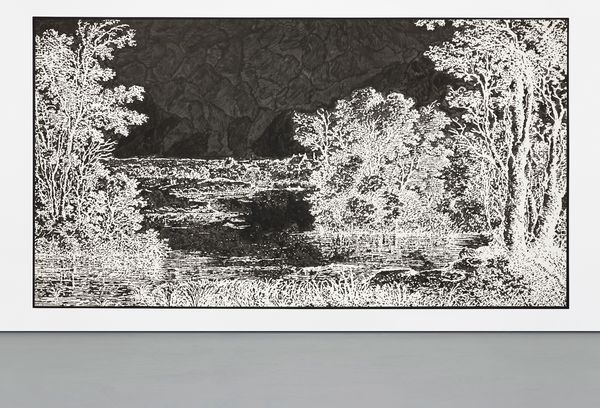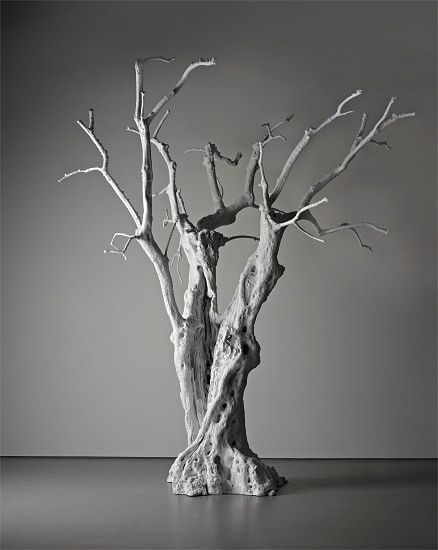Ugo Rondinone Clockwork for Oracles, at Phillips Paris, 46 Rue du Bac, through 2 March 2019
Phillips: Tell me a little about how this exhibition came to Phillips. When did you envision it for our Paris gallery?
Maria Cifuentes: How? Out of a deep and longstanding admiration for Ugo Rondinone. When? Right before the artist's exhibition at the Bass Museum of Art, sponsored by Phillips in 2017-2018. It was at that moment that I secretly began to imagine Rondinone transforming our space, but the opportunity did not come up until last September. We were enthused to have the show overlap with FIAC; Paris has been bursting with great quality exhibitions since then.
Another reason motivated me to organize this exhibition. The art market has not always managed to seize the full complexity of an artist’s work, and Rondinone's is no exception to this phenomenon. Our site-specific exhibition aims to rectify this gap and honor the richness of his practice.
P: In a body of work that is often changing, how do you identify Rondinone's DNA?
MC: Rondinone jumps very naturally from sculpture to painting, video to performance, always with a wise dose of dramaturgy that allows volume, space, sound and painting to coexist and interact. Although the artist’s body of work is in constant transformation, its multifaceted nature is consistent within a global corpus. Every work can be traced back to a single and singular voice.
P: How does the site-specific installation in our Parisian space fit into Rondinone's oeuvre as a whole?
MC: Rondinone has an intuitive and attentive understanding of scale and space. He respects the soul of a place, its genius loci, which is why he is able to transform it so magically.
Clockwork for Oracles is an immersive installation where architecture, painting and sculpture collaborate to produce a mood-shifting experience. Although the installation is decidedly hypnotic, it does not aim to alienate the viewer. It conjures a childlike playfulness, a naïve sense of astonishment, while simultaneously compelling deeper reflection.
When preparing the show I was particularly impressed by how meticulous and precise Rondinone is about his work; he leaves no space for compromise to achieve his vision. All his series thoroughly explore and push the limits of their own formal and conceptual possibilities: from the unadorned monolithic standing figures or the tree sculptures, to the colorful mountain series, or target-like 'suns', the lightbulbs, clowns, windows and rainbows... the common denominator remains the artist's compelling capacity to engage both sides of the brain, simultaneously providing an emotional experience and an intellectual exercise, as deep as one allows it to be.
I feel his work can be easily misread as superficial, yet the immediately rewarding sensation it provides is usually balanced with deep commentary on society and human nature as well as existential reflections on life, death and desire.
Above from top: Ugo Rondinone Small Blue, Green and Pink Mountain, 2017 (sold at Phillips New York, May 2018); The Pleased and Delighted, 2013 (sold at Phillips London, June 2016)
P: How, if at all, does the Phillips gallery space change or inform the work?
MC: Well, it's simple: one day you are going to the office through a conventional gallery space, the next you are in a sort of David Lynch set for Alice in Wonderland! The experience of color is so powerful that it feels as if you had a black and white filter on the retina before entering the room.
On previous occasions, the work was most frequently displayed on a single monumental wall; at the Bass Museum in Miami, it was a prelude to Good Evening Beautiful Blue. Our space is more intimate and the installation is spread across two rooms instead of one, making the experience of the work all-the-more hypnotic and immersive. It's a color feast that elevates the spirits; yet when you look closely, there is a troubling and almost deranging dimension to it.
The installation operates as a time and space shifter. Although it refers to a very specific moment in history, documented by the dated journals (in our case Le Monde's 2018 yearly edition), time is suspended and rendered ever present through the echoing window-mirrors: 52 windows unfold, seemingly endlessly, to represent the 52 weeks of the year. The journals are dramatically scrutinized by the windows; however, they send us back to ourselves. The actual windows and doors in the gallery space are also paradoxical: Ugo has covered them in white paint. Why such a multiplication of windows and no possibility to look through them? Rather than attending to "objective" reality (via the journals), they magnify the subjective perspective of each viewer. This mise en abyme, orchestrated by an exponential game of reflections, confronts the viewer to his or her own perception of reality, thus forming a "meta"-reality that recalls Alice's Wonderland, in French also known as "De l'autre côté du miroir" (literally, "Beyond the mirror").
Related Video: Tapestry Expanded: Ugo Rondinone at the Bass Museum
P: Would you also identify a main concept or message?
MC: With Rondinone, many messages and meanings coexist; he works like a poet where meaning is not tyrannically imposed but suggested. I think his titles often provide good keys to solve their own conundrum. Clockwork for Oracles is a beautiful oxymoron; it implies that the enigma of the future can be figured out through precise and hard work, like that carried out by a tireless watchmaker. This, in turn, implies that there is hope beyond the grotesque realities displayed on the journals' front covers.
Ultimately the main message that I grasp is a latent know thyself — the classic Nosce te ipsum. Rondinone invites the spectator to adopt a point of view, to take a stance regarding these randomly juxtaposed pieces of news. In the installation, we can see Le Monde's update on the humanitarian crisis in Yemen next to Les Bleus World Cup triumph, and president Emmanuel Macron's comment on the environment next to a plastic surgery ad. Such randomness calls for criteria: your own! Information alone won't produce critical thinking.
If, for Hegel, the act of reading journals replaces the morning prayer in the midst of the French Revolution, Rondinone seems to acknowledge the impossibility of understanding, processing or even physically embracing the ridiculous amount of information that we are bombarded with these days. Rather than a narcissistic delirium of mirrors, what I see is Rondinone's invitation to cultivate yourself and trust your own voice, as opposed to passively consuming daily news. This seems particularly relevant in the era of post-truth and fake news...one must take a stance within the world.
[Rondinone] engages both sides of the brain, providing an experience simultaneously emotional and intellectual, as deep as one allows it to be.
P: That is why we could talk of spectator rather than viewer?
MC: Definitely, and even further: the spectator becomes its own spectacle. After all, "spectator" and "spectacle" share the same etymologic root as the vulgar Latin speculum (mirror). This confrontation to our own spectacle is quite radical in Clockwork for Oracles. The work invokes the past (by the journals), the present (by the mirrors) and the future (by the notion of oracles). Conceived ten years ago, it is actualized by the journals and reenacted by the viewer, who is the real protagonist of the work: It is by looking into who we are, into our past and present, provided the local and global circumstances that surround us, that we can consult the oracle.
Above from top: Ugo Rondinone VIERUNDZWANZIGSTERNOVEMBERNEUNZEHNHUNDERTFÜNFUNDNEUNZIG, 1995 (Sold at Phillips New York, February 2018); Get up girl a sun is running the world, 2006 (Sold at Phillips London, June 2011)
P: Windows are often associated with eyes. Do you think Rondinone is attached to this metaphor or any poetry in particular?
MC: Though it may be unrelated, I immediately saw a link between Rondinone's work and a poem by Rainer Maria Rilke called 'Windows', from his French poems. Like many artists before them, Rilke and Rondinone seemed fascinated by the promise that windows carry. An interesting fact is that Rilke got the inspiration for his poem when traveling with his lover Baladine Klossowska (Balthus' mother) through Switzerland, Rondinone's motherland. Rilke thought that Swiss cottage windows looked like painting frames for the stories lived inside, or on the other direction the frame for the sublime coexisting with the banal taking place outside. But a window can also turn into an abyss, a place to fall from. Here we talk about mixed feelings again; the installation becomes a receptacle that deals with contradictory emotions and paradoxical ideas. Rondinone plays with all these polysemic realities by transforming windows into eyes, mirrors, that frame the daily realities of the world.
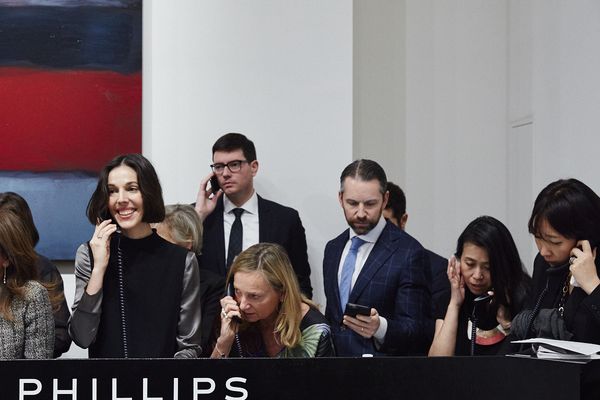
Specialist Maria Cifuentes (left) seen phone bidding during a 20th Century & Contemporary Art Evening Sale
For Rilke, the windows contain the quintessence of a phenomenon that he named "World-inner-space." This concept designates the space where the outside and the inside worlds merge into a single emotional plane. It is an in-between realm of the self that allows a lively engagement with the World while simultaneously being preserved from it. Rondinone’s mirror-like windows seem to echo this concept coined by Rilke.


